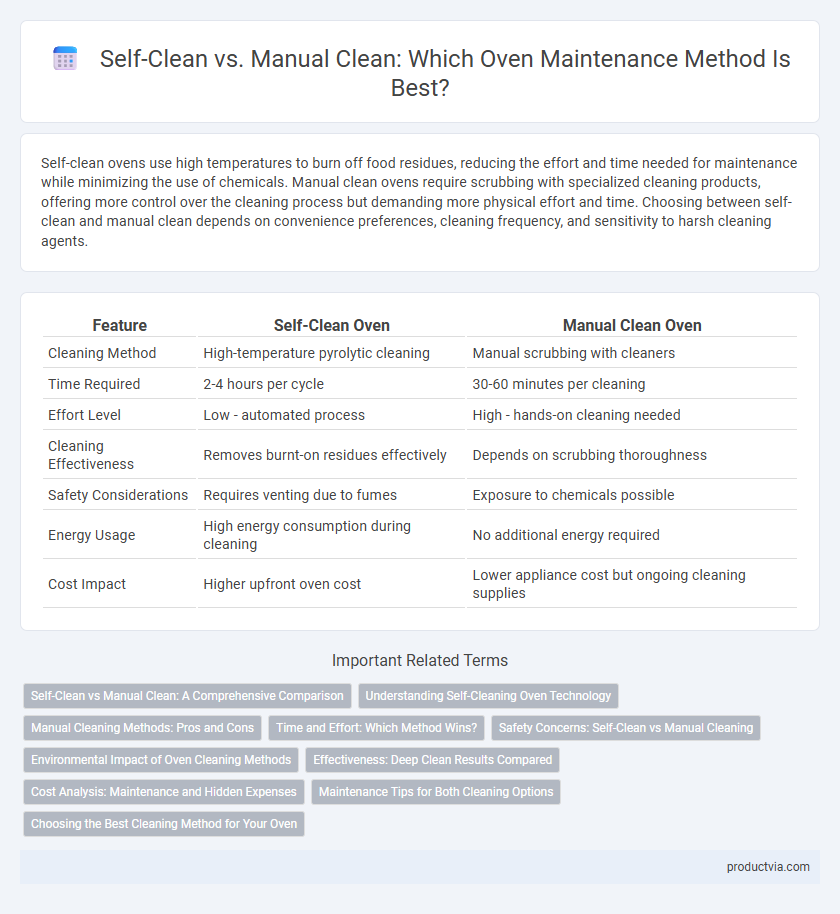Self-clean ovens use high temperatures to burn off food residues, reducing the effort and time needed for maintenance while minimizing the use of chemicals. Manual clean ovens require scrubbing with specialized cleaning products, offering more control over the cleaning process but demanding more physical effort and time. Choosing between self-clean and manual clean depends on convenience preferences, cleaning frequency, and sensitivity to harsh cleaning agents.
Table of Comparison
| Feature | Self-Clean Oven | Manual Clean Oven |
|---|---|---|
| Cleaning Method | High-temperature pyrolytic cleaning | Manual scrubbing with cleaners |
| Time Required | 2-4 hours per cycle | 30-60 minutes per cleaning |
| Effort Level | Low - automated process | High - hands-on cleaning needed |
| Cleaning Effectiveness | Removes burnt-on residues effectively | Depends on scrubbing thoroughness |
| Safety Considerations | Requires venting due to fumes | Exposure to chemicals possible |
| Energy Usage | High energy consumption during cleaning | No additional energy required |
| Cost Impact | Higher upfront oven cost | Lower appliance cost but ongoing cleaning supplies |
Self-Clean vs Manual Clean: A Comprehensive Comparison
Self-clean ovens use high temperatures around 900degF to burn off food residues into ash, reducing the need for scrubbing and harsh chemicals. Manual clean ovens require regular scrubbing with oven-safe cleaners and often involve more effort and time to remove baked-on grease and spills. Comparing energy efficiency and maintenance frequency, self-clean cycles consume more power but offer convenience, while manual cleaning is less energy-intensive but demands consistent upkeep.
Understanding Self-Cleaning Oven Technology
Self-cleaning ovens use high temperatures ranging from 800 to 1,000 degrees Fahrenheit to incinerate food residues and grease into ash, simplifying maintenance by reducing the need for scrubbing. The pyrolytic cleaning cycle typically lasts between 2 to 4 hours, during which the oven door locks automatically to ensure safety. This technology enhances convenience and efficiency compared to manual cleaning methods that require chemical cleaners and significant elbow grease.
Manual Cleaning Methods: Pros and Cons
Manual cleaning methods for ovens offer precise control over cleaning agents and areas, allowing for targeted removal of stubborn grease and burnt residues without the high heat required in self-clean cycles. These methods are typically less expensive and avoid the strong odors and high energy use associated with self-clean ovens. However, manual cleaning demands more time, physical effort, and exposure to potentially harsh chemical cleaners, which may pose safety risks and require proper ventilation.
Time and Effort: Which Method Wins?
Self-clean ovens use high temperatures around 900degF to ash residues, significantly reducing cleaning time to about 2-4 hours with minimal effort, while manual cleaning demands several hours of scrubbing and chemical use. Although manual cleaning offers control over chemical exposure and precision in delicate areas, it requires substantial physical exertion and extended time investment. For busy households prioritizing efficiency, self-clean ovens present a clear advantage in saving both time and effort during oven maintenance.
Safety Concerns: Self-Clean vs Manual Cleaning
Self-clean ovens use high temperatures around 900degF to burn off food residue, reducing chemical exposure but posing risks like burns and smoke inhalation, especially if safety precautions are ignored. Manual cleaning involves chemical cleaners or scrubbing, which may expose users to harsh chemicals and require protective gear to avoid skin irritation or respiratory issues. Choosing between self-clean and manual methods depends on balancing direct heat hazards against chemical risks for safer oven maintenance.
Environmental Impact of Oven Cleaning Methods
Self-clean ovens use high temperatures to incinerate food residue, reducing the need for chemical cleaners but consuming significant energy, whereas manual cleaning involves chemical detergents that can contribute to water pollution. The environmental impact of self-clean cycles is often higher in terms of energy use, but manual cleaning poses risks of toxic runoff and air quality harm due to chemical fumes. Choosing ovens with efficient self-clean technology or eco-friendly manual cleaning products can minimize ecological damage during maintenance.
Effectiveness: Deep Clean Results Compared
Self-clean ovens use high heat up to 900degF to incinerate food residue into ash, delivering a deep clean with minimal effort and no chemical use, while manual cleaning requires scrubbing with solvents or baking soda solutions to remove grime. The effectiveness of self-clean cycle often surpasses manual methods by reaching and dissolving tough, baked-on deposits in hard-to-reach areas where manual tools may fall short. However, manual cleaning allows for precise attention to delicate oven components that high-heat cycles may damage, making a combined approach effective for comprehensive oven maintenance.
Cost Analysis: Maintenance and Hidden Expenses
Self-clean ovens typically incur higher upfront costs but reduce long-term maintenance expenses by preventing grime buildup and minimizing the need for harsh cleaning agents. Manual clean ovens have lower initial prices but often result in increased hidden costs, including labor time, specialized cleaning products, and potential damage from abrasive techniques. Analyzing total cost of ownership reveals that self-clean ovens may offer better value by extending appliance lifespan and lowering frequent maintenance fees.
Maintenance Tips for Both Cleaning Options
Self-clean ovens use high temperatures to eliminate residue, reducing the need for harsh chemicals and making maintenance easier by requiring only occasional wiping after cycles. Manual clean ovens demand regular scrubbing with oven-specific cleaners or baking soda paste to remove grease and food buildup effectively. For both types, promptly wiping spills, avoiding abrasive tools, and maintaining door seals ensures long-lasting performance and hygiene.
Choosing the Best Cleaning Method for Your Oven
Choosing between self-clean and manual clean methods for oven maintenance depends on factors like oven type, cleaning frequency, and user convenience. Self-clean ovens use high temperatures up to 900degF (482degC) to incinerate food residue, reducing manual effort but requiring a cooldown period and proper ventilation. Manual cleaning involves scrubbing with oven-safe cleaners or baking soda paste, allowing targeted stain removal without high energy use but demanding more time and elbow grease.
Self-Clean vs Manual Clean for Oven Maintenance Infographic

 productvia.com
productvia.com